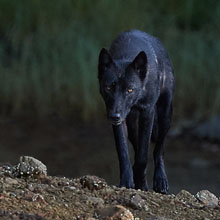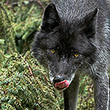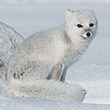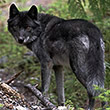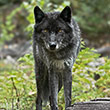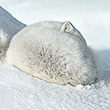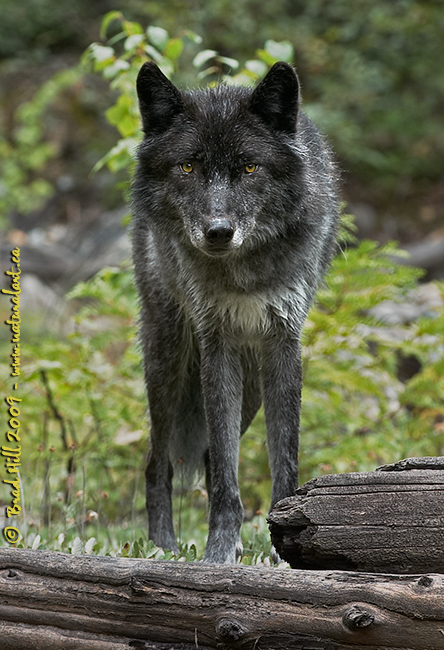
Availability: Limited Edition Print; RF Stock (??)
In the Field
Gray Wolf, Yellow Eyes. Red Burn Creek, BC, Canada. August 27, 2004.
Wolves have entrancing, penetrating and almost haunting eyes. This may be one reason why humans have so often attributed spiritual (and too often "devilish") significance to wolves. In his book "Of Wolves and Men" Barry Lopez recounts much of the ancient lore and myths surrounding wolves and, in particular, their disasterous relationship with humans. It's fascinating reading and can provide insight into why humans have chosen wolves as their favourite scapegoat.
In this image I chose a vertical format to accentuate the "limbiness" of the wolf. I liked the way the gray, weathered logs in the foreground worked with wolf's coat colour (and how they added more neutral tones to the image which, in turn, helped the colour of the eyes "pop"). I intentionally chose an aperture that would assist in keeping both the logs AND the wolf in sharp focus (yet would blur the background).
Disclosure of Subject Status: When photographed, this wolf was free-ranging in a natural environment and not restrained in any way. However, it was/is NOT a fully wild wolf - it inhabited a nearby wolf education and rehabilitation centre and was released from captivity shortly before this image was taken. None of the photographs exhibited on this website are of captive animals in zoos or game farms or restrained in any fashion.
Behind the Camera
Gray Wolf, Yellow Eyes. Red Burn Creek, BC, Canada. August 27, 2004.
Digital Capture; Compressed RAW (NEF) format; ISO 200.
Nikon D2H with with Nikon 70-200mm f/2.8G ED-IF AF-S VR lens @ 200 mm (300 mm equivalent with digital conversion factor) supported on Manfrotto 680B monopod with Really Right Stuff BH-55 ballhead. VR turned to "On" and in "Normal" mode.
1/80s @ f8; -0.7 stop exposure compensation from matrix-metered exposure setting.
At the Computer
Gray Wolf, Yellow Eyes. Red Burn Creek, BC, Canada. August 27, 2004.
RAW Conversion to 16-bit TIFF, including first-pass sharpening and tone curve adjustment, using Phase One's C1 Pro.
All further digital correction on 16-bit TIFF file using Adobe's Photoshop CS, including selective desaturation, selective saturation enhancement, selective use of Shadow/Highlight filter, and selective sharpening for web output.
Conservation
Gray Wolf, Yellow Eyes. Red Burn Creek, BC, Canada. August 27, 2004.
Ten percent of the revenue generated by this image will be donated to Wildsight.
Species Status in Canada*: Only Eastern Wolf listed as species of "Special Concern" in May, 2001. Other populations not listed as Endangered or Threatened.
Species Status in the United States: Western Great Lakes population removed from list of Endangered and Threatened species on January 29, 2007. Proposed delisting of Northern Rockies population on January 29, 2007. Both actions are a direct result of a successful recovery plan. Congratulations! Wolves in other areas of the lower 48 states (including the Southwest wolf population), remain on Endangered Species list.
Probably no species alive today has suffered as much direct persecution from humans as has the Gray Wolf (Canis lupus). Once extremely widespread in North America, the Gray Wolf was virtually extirpated from the contiguous 48 states of America and now is regularly found within only a fraction of its historical range in Canada. While the Gray Wolf is currently listed as endangered in most of the 48 lower states of the United States and enjoys the privileges associated with such status (if lack of persecution and abuse can be thought of as a privilege), it is still official policy in much of Canada to rid the countryside of this magnificent keystone predator. As an example, in British Columbia, there is NO closed season on the wolf in most hunting jurisdictions and opportunistic slaughter is encouraged by policy (it is the ONLY fur-bearing species for which NO hunting license is required in British Columbia!). Conservation of wolves presents a puzzling paradox. Reduced to the most basic principles, wolf conservation is simplistic: we need only to stop persecuting this species in order for it to survive. Yet accomplishing this invariably proves incredibly difficult - it's as though wolf persecution has been institutionalized directly into government (and societal) bureaucracy.
I commend and support those individuals and groups that have the patience and determination to fight for the Gray Wolf. This wolf was photographed in the Columbia Valley of southeast British Columbia. Wildsight is an effective conservation organization that protects biodiversity and promotes sustainable communities in Canada's Columbia and Rocky Mountains. Support for Wildsight, through donation or becoming a member, will help ensure that they remain effective in their efforts to conserve threatened or endangered species and ecosystems.
*as determined by COSEWIC: The Committee on the Status of Endangered Wildlife in Canada


















